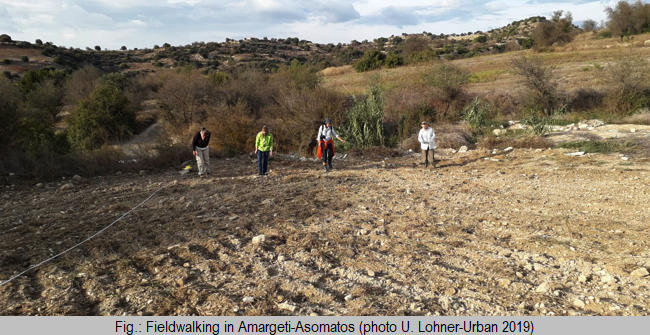The 2019 campaign aimed at locating the place excavated by D. G. Hogarth and the British Exploration Fund in 1888, when a sanctuary site dedicated to Opaon or Apollon Melanthios in the site Petros Anthropos was discovered. Beyond that, the researches intended to gather all archaeological information in the supposed area in order to document and analyse human activities and archaeological remains of all periods. In order to optimise the short survey campaign, aerial photographs and satellite data of the survey area were analysed in advance at Graz University and at Cyprus University of Technology, Remote Sensing & Geo-Environment Research Lab – Eratosthenes Research Centre (Vasiliki Lysandrou and Athos Agapiou). Several circular subsurface structures were detected at Asomatos; a rectangular one could be spotted at Petros Anthropos. The analysis of the photos, however, clearly showed that the best results are to be expected from pre1980s images. The reason for this is increasing agricultural activities which had a negative impact on archaeological sites. Subsequently, intensive field walking was undertaken in both sites, in grids of 10 x 10 m or 20 x 20 m. The Ground Penetrating Radar team of Rainer Morawetz and Andreas Milchrahm covered partially the same areas as the field walking team. In general, the quality of the collected data from the Asomatos field was about 3-4/5 (with 5 is best), but the interpretation of the results is quite difficult. The geophysical analysis is still ongoing, first results, however, failed to come up to expectations, maybe due to complex geological and surface conditions on the site.

The Asomatos site (Fig.) in particular, which was said by the local population to have produced many statuettes and figurines, proved to be most promising for further research. Around the ruins of a small church, dedicated to Ag. Asomatos, the archangels St. Michael or St. Gabriel, the survey team found pottery dating from the Bronze Age through to the mediaeval period and heads and other parts of human and animal terracotta figurines. These have dates ranging from the Archaic to the Hellenistic periods. The site Petros Anthropos, situated northwest of Asomatos, produced pottery from the Bronze Age to Late Antiquity and a small number of fragmented terracotta figurines.
Processing and studying the finds and continuation of the survey are planned for 2020.
![]() © Gabriele Koiner, Gabriele Ambros, Eva Christof, Ute Lohner-Urban, Alexandra Puhm, Sabine Sturmann, Rainer Morawetz, Andreas Milchrahm
© Gabriele Koiner, Gabriele Ambros, Eva Christof, Ute Lohner-Urban, Alexandra Puhm, Sabine Sturmann, Rainer Morawetz, Andreas Milchrahm
e-mail: gabriele.erath@uni-graz.at
This article should be cited like this: G. Koiner et al., The Graz Amargeti Survey 2019, Pafos District, Cyprus, Forum Archaeologiae 94/III/2020 (http://farch.net).